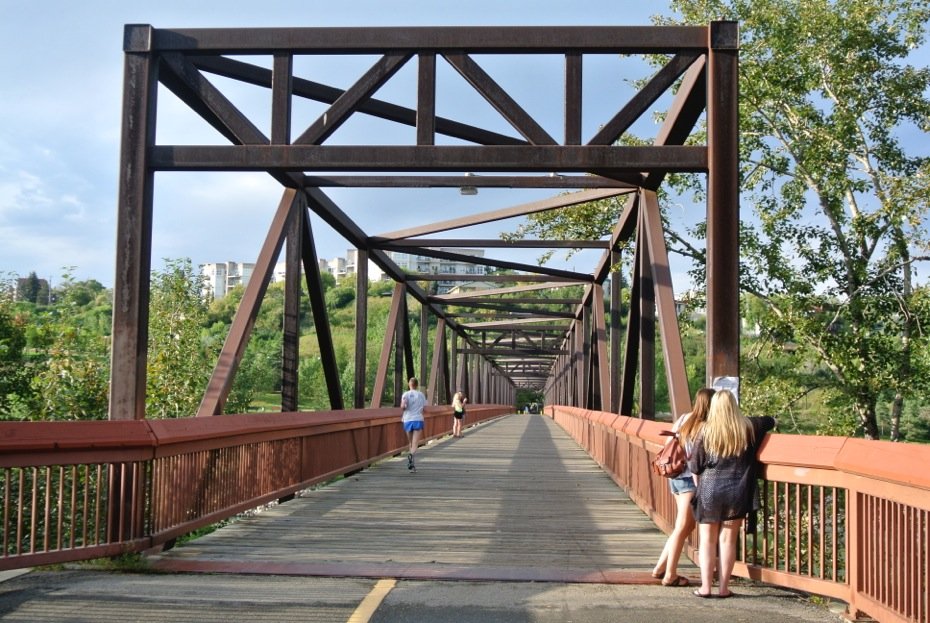Fort Saskatchewan naturalists raise concern over vandalism to trails
Susan Gronau with the Fort Saskatchewan Naturalist Society says that unauthorized trails in Ross Creek and Turner Park have been meddling with the fragile ecosystem that exists in the area. "The creek is littered and plugged with chain sawed live trees and dead logs from the ground, small trees were cut down, bundled, and tossed to the side," said Gronau.
The damage that some of those trails can inflict on the environment can be more wide-reaching than you think. One of these trails goes right through a patch of Yellow Lady's Slipper, a rare plant in the area. Forest ecosystems are especially fragile once the snow melts, with many animals breeding and plants beginning to bloom.
Gronau mentioned that most of the unpaved trails in Fort Saskatchewan were created without permission of the city council, and she hopes that there will be more restrictions on the trails in the future. "For both Turner Park and Ross Creek, if there has to be a trail there, shut down all of them but one," said Gronau.
What do wildlife do to stay cool in summer heat
Animals use various methods of evaporative cooling to regulate their body temperatures. Rabbits and foxes have thin skin paired with blood vessels near the surface in their large ears to help shed excess body heat. Bees carry water droplets back to their hives and fan them with their wings, effectively creating their own air conditioning.
Storks and vultures perform guttural fluttering, which is similar to panting, and defecate on their legs to stay cool. Like hibernation in cold weather, some snails, worms and small mammals will go into estivation in hot weather, hiding from the heat and saving their energy.
Ground squirrels and prairie dogs, take refuge underground on hot days. They will even build special tunnels for optimal airflow that aids in keeping their dens cool. Bushy-tailed animals, like tree squirrels, use their tails like an umbrella to create their own shade.
Unlike mammals, reptiles and amphibians are poikilotherms and use their environment to manipulate their body temperature. They will bask in the sun to warm up and will seek water, mud, or crevices when they need to cool down. https://www.ealt.ca/blog/fun-facts-keeping-cool-in-the-animal-kingdom
Eugenics and the Leilani Muir footbridge
The footbridge in the photo has been replaced by the Tawatinâ LRT Bridge. In 2011, the footbridge was informally named the Leilani Muir Foot Bridge in a Works Festival project. Small plaques were affixed to the railings and remained there until 2016.
Muir was born July 15, 1944 in Calgary. In 1955, Leilani’s mother admitted her to the Provincial Training School for Mental Defectives in Red Deer, later known as the Michener Center. A precondition was consent permitting sterilization, which Leilani’s mother gave.
In 1959, Leilani underwent a bilateral salpingectomy, cutting of the fallopian tubes. Leilani was told only that she was having her appendix removed. Leilani’s sterilization occurred under the premise of Alberta’s Sexual Sterilization Act. Leilani left the training school in 1965 to begin an independent life.
After learning about her sterilization through a medical test, Muir spent years trying to have the damage reversed. She hired two Edmonton lawyers, and in 1996 she became the first person to successfully sue the Alberta government for wrongful sterilization. She was awarded $740,780, plus $230,000 for legal costs.
In her decision, Justice Joanne B. Veit stated, “The circumstances of Ms. Muir’s sterilization were so high-handed and so contemptuous of the statutory authority…and…so little respected Ms. Muir’s human dignity that the community’s, and the court’s sense of decency is offended.”
Leilani’s case opened the door for similar class action lawsuits. By 1999, the province had paid $142 million in settlement costs to over 700 victims. Leilani Muir O’Malley died on March 14, 2016. The Sexual Sterilization Act was repealed in 1972 by Peter Lougheed’s provincial government. https://citymuseumedmonton.ca/2023/03/14/leilani-muir-and-eugenics-in-alberta/
Tree planting as climate action is no solution without animals
Wayne Lynch photo
Tree-planting, the main so-called nature-based solution intended to help draw down carbon dioxide from the atmosphere, has become a synonym for climate action. A recent paper published in Nature’s climate change journal says trees might not be able to do their carbon-uptake job efficiently without the right animals in their ecosystem.
That is because, in the words of the paper, animals “animate the carbon cycle” through their behavior and roles in the ecosystem. That goes far beyond forests. Take wildebeests. They turn the Serengeti into a carbon sink by grazing, which reduces wildfire risk. Their waste, which contains carbon from the vegetation, is then buried in the soil by insects.
In Canada’s tundra, herds of muskox compact the snow, which keeps the soil frozen, therefore reducing methane emissions and increasing albedo, or the ability to reflect sunlight, which cools the local environment.
It is frustrating that efforts to protect biodiversity and halt climate change are treated separately. The paper’s co-author says people should start thinking holistically. By expanding the dimensions of the problem, we can arrive at solutions that are beneficial for both biodiversity and climate. https://www.bloomberg.com/opinion/articles/2023-04-11/rewilding-nature-is-no-solution-if-all-you-ve-got-are-trees?leadSource=uverify%20wall
Kirsten writes “We enjoy the River Valley News. Always new stuff to learn and it helps us see the wonders right outside our door.”
Vaulted Willow by Marc Fornes & THEVERYMANY. Borden Park. Doyle C. Marko/DCM Photography. https://www.edmontonpublicart.ca/#!/details/141
Comment or contribution
Please note that articles may not reflect the position of NSRVCS. River Valley News is meant to be a clearinghouse for the wide variety of opinions and ideas about Edmonton’s River Valley. Email river valley photos, event information, comments, or questions to nsrivervalley@gmail.com
Sincerely yours,
Harvey Voogd
North Saskatchewan River Valley Conservation Society
780.691.1712






